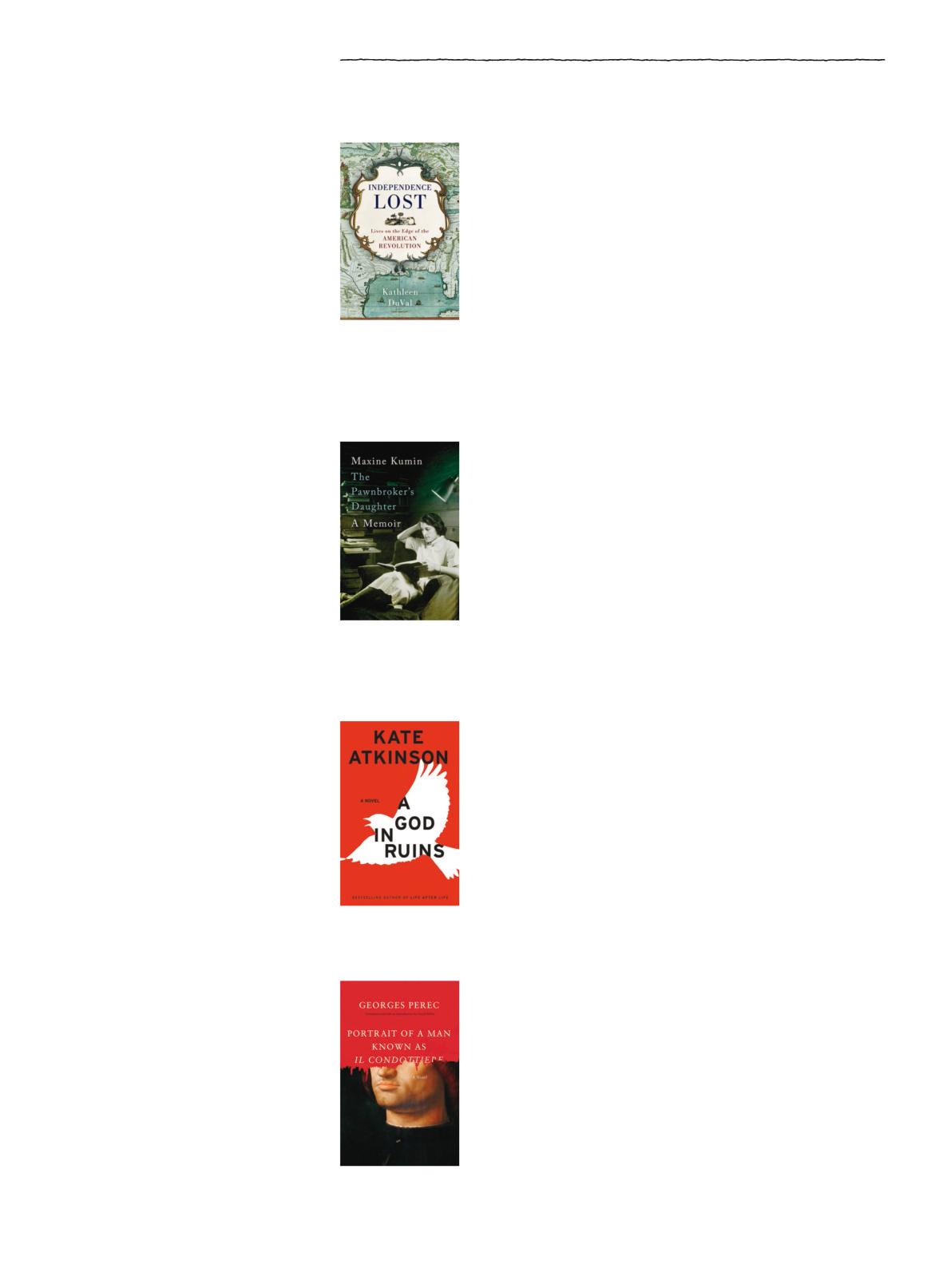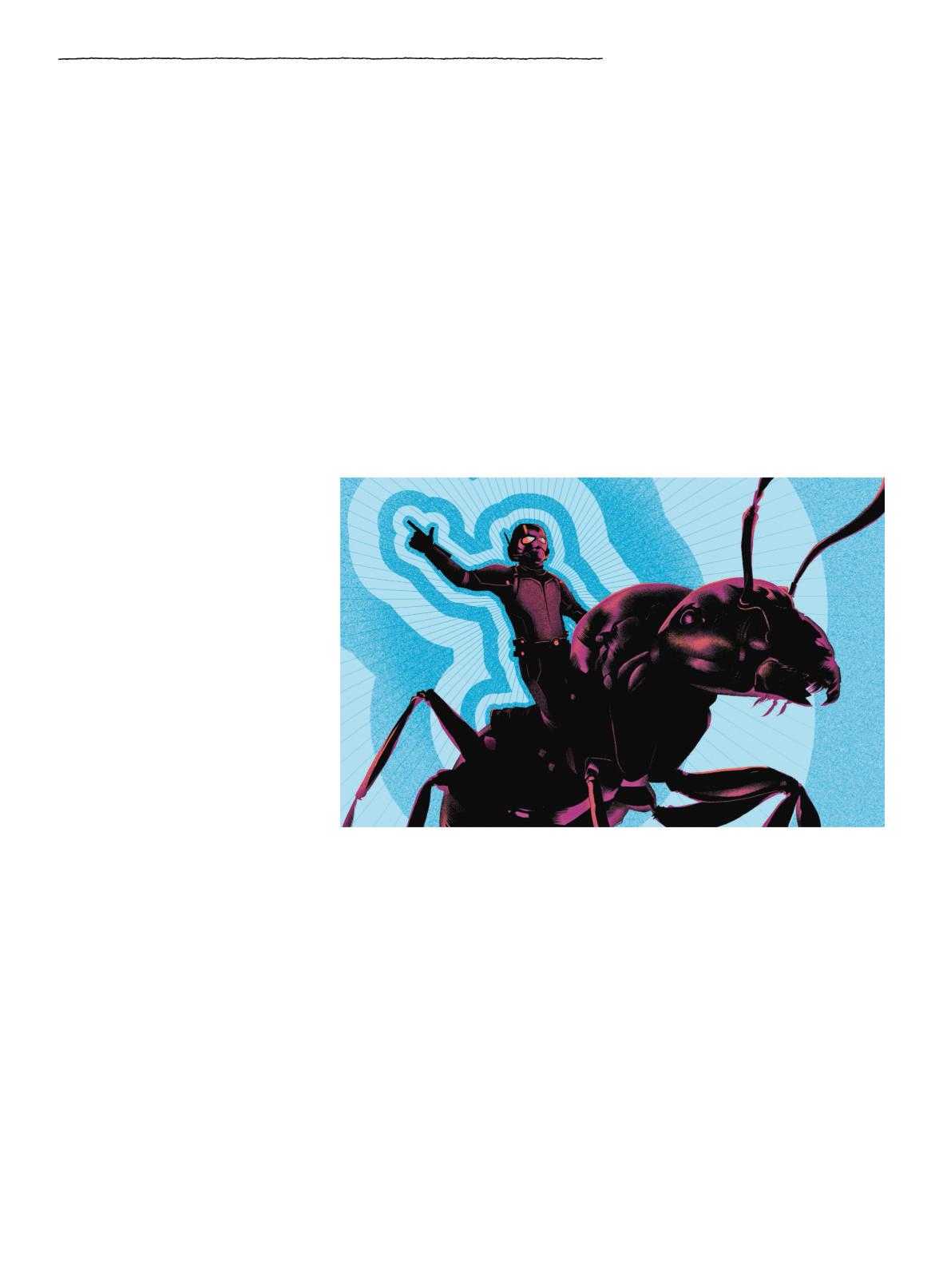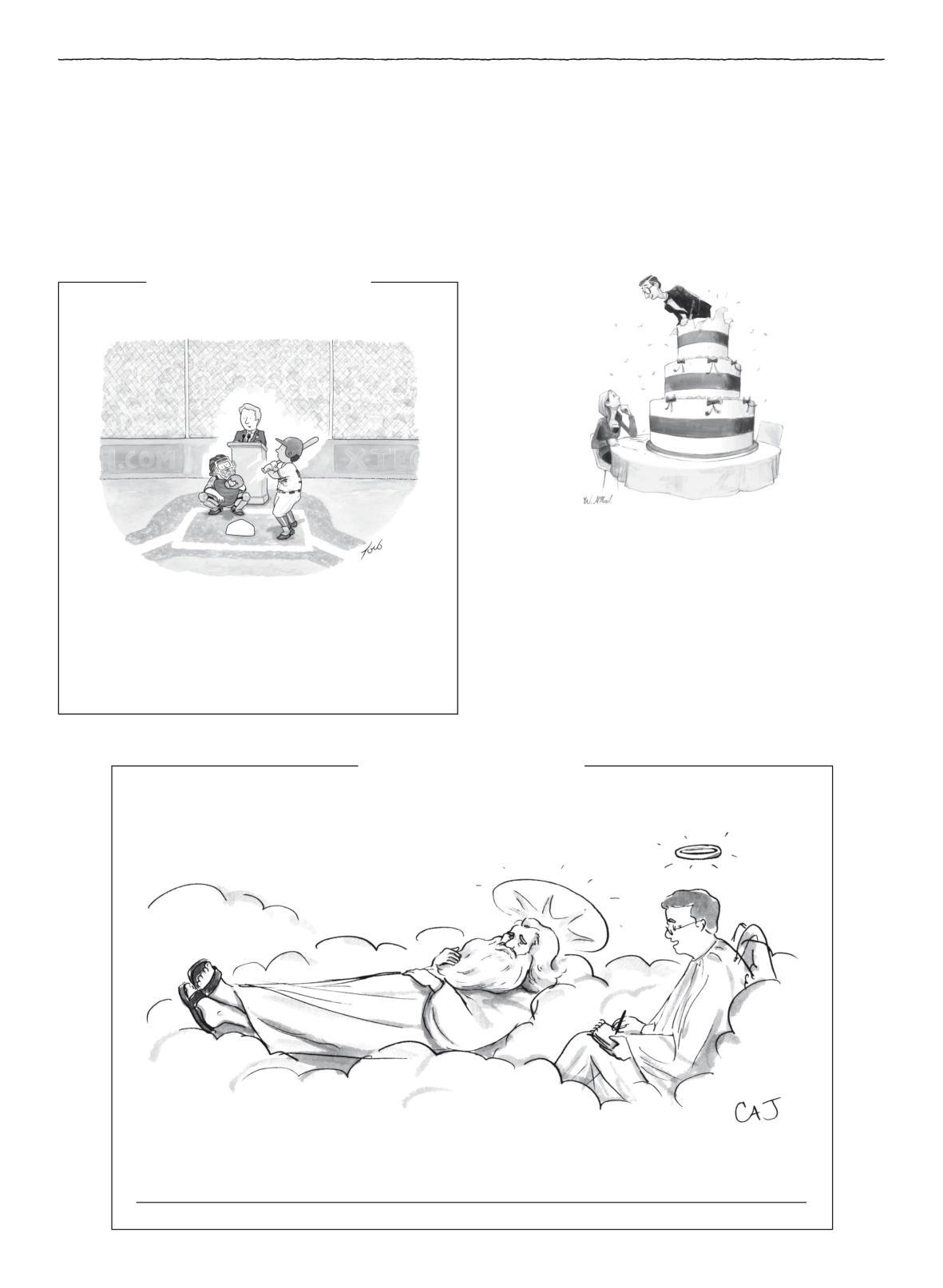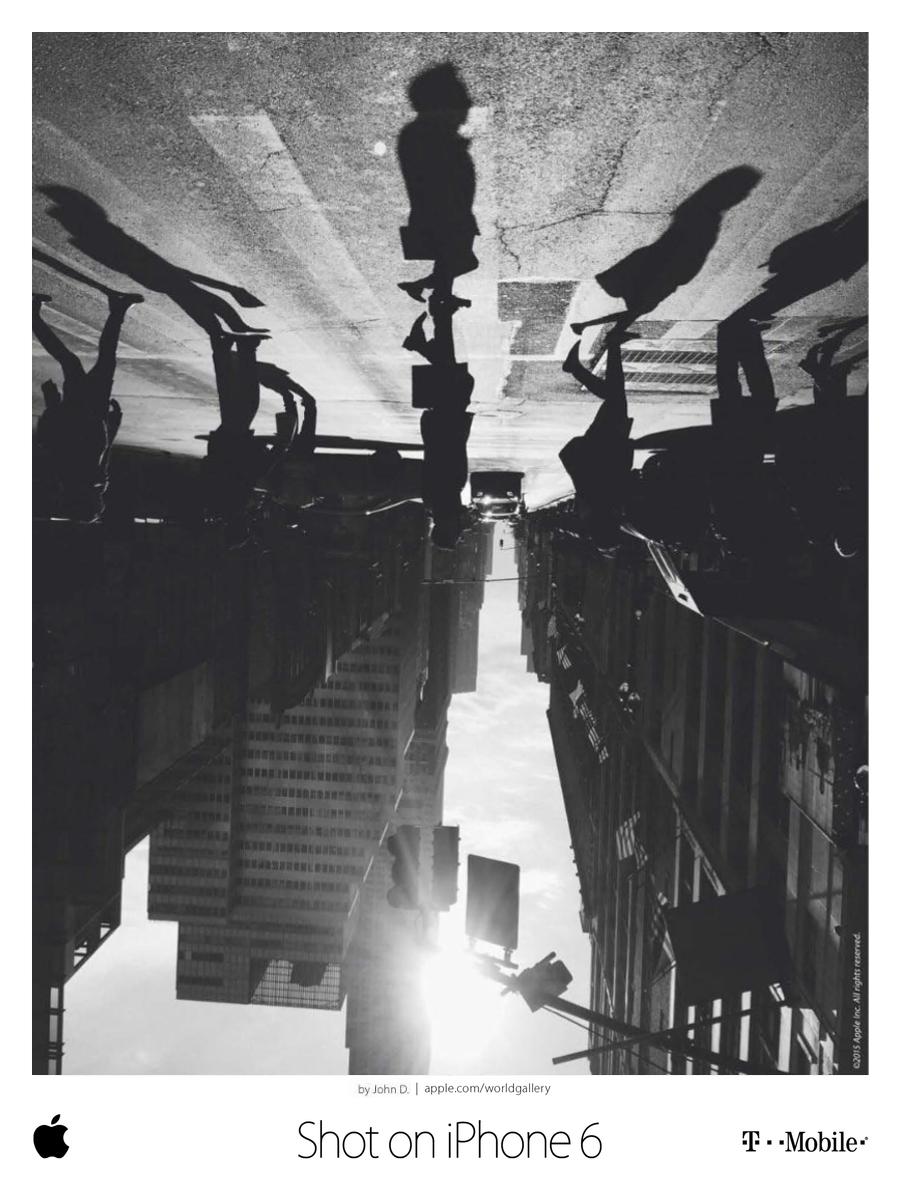
23 minute read
Briefly Noted
from “Mockingbird”—but what effect could Lee have expected them to have on readers who don’t? Indeed, the book as a book barely makes sense if you don’t know “Mockingbird.” If “Watchman” is a first novel, even in draft, it is unlike any first novel this reader is aware of: very short on the kind of autobiographical single-mindedness that first novels usually present, and which “Mockingbird” is filled with, and very long on the kind of discursive matter that novelists will take up when their opinions begin to count.
It is, I suppose, possible that Lee wrote it as we have it, and that her ingenious editor, setting an all-time record for editorial ingenuity, saw in a few paragraphs referring to the trial of a young black man the material for a masterpiece. But it would not be surprising if this novel turns out to be a revised version of an early draft, returned to later, with an eye to writing the “race novel” that elsewhere Harper Lee has mentioned as an ambition. (The manuscript might then have been put aside by the author as undramatic and too abstract.) It is sad, though, to think that the preoccupations of this book, however much they may intersect our own preoccupations of the moment, might eclipse her greater poetic talents, evident here, and so beautifully fulfilled in “To Kill a Mockingbird.” There is a genuine dramatic climax, worthy of the writer’s gifts, offered and then evaded in “Watchman.” In the book’s toughest scene, Scout goes to visit Calpurnia, the black woman who brought her and Jem up, with infinite- seeming love, after Atticus agreed to defend Cal’s grandson from a charge of manslaughter. Scout is heartbroken to find that her beloved mother figure is cautiously distanced from her:
Advertisement
“Cal,” she cried, “Cal, Cal, Cal, what are you doing to me? What’s the matter? I’m your baby, have you forgotten me? Why are you shutting me out? What are you doing to me?”
Calpurnia lifted her hands and brought them down softly on the arms of the rocker. Her face was a million tiny wrinkles, and her eyes were dim behind thick lenses. “What are you all doing to us?” she said.
Then Scout asks, “Did you hate us?,” and Calpurnia shakes her head no. This is credible. But the scene, and the book, would have been stronger if she hadn’t.
INDEPENDENCE LOST, by Kathleen DuVal (Random House). This intrepid history of the American Revolution shifts the focus from the rebellious thirteen colonies to the Gulf Coast and the Mississippi valley, where Native Americans, African slaves, and Spanish, French, and British colonials were fighting very different battles. Here, DuVal writes, the vision for the continent was one of “multiple empires and powerful Indian nations”; it was highly unlikely that the rebels would win, much less that what Thomas Jefferson termed their “empire of liberty” would later destroy an intricate array of economic alliances and territorial agreements. The rebels’ vision of independence came at the expense of others’. Its realization involved the erasure of one people and the enslavement of another, and was a disaster for women of all races.
THE PAWNBROKER’S DAUGHTER, by Maxine Kumin (Norton). Kumin, who died last year, began her career as a stifled housewife selling light verse to magazines, grew into a voice of confession and feminist dissent, and, finally, became Poet Laureate and an eminent New England nature writer. This memoir lingers on moments of private joy. The first half is dominated by courtship: Kumin’s husband, a soldier working on the Manhattan Project, wrote funny love letters from Los Alamos. Later, a prestigious awards banquet is recounted merely to explain the arrival of a dog, Rilke, in her life. Some of her political poems are reproduced here, their fierceness almost incongruous alongside descriptions of the charmed placidity of her farm.
A GOD IN RUINS, by Kate Atkinson (Little, Brown). Atkinson’s previous novel, “Life After Life,” was built around an arresting narrative conceit: Ursula Todd, a young Englishwoman, repeatedly dies and starts her life again. This follow-up tracks Ursula’s younger brother, Teddy, a favorite son who flies an R.A.F. bomber during the Second World War and remains kind, thoughtful, and patient through a life of quiet sadness: he is widowed early, has a selfish daughter, and struggles to connect with his grandchildren. Teddy, unlike his sister, lives only one life, but Atkinson’s deft handling of time, as she jumps from boyhood to old age and back, is impressive.
PORTRAIT OF A MAN KNOWN AS IL CONDOTTIERE, by Georges Perec, translated from the French by David Bellos (Chicago). This unpublished early novel by a famous French experimentalist is a youthful riff on Dostoyevsky and Poe. An art forger murders his dealer, in an act of existential despair, after failing to create a convincingly “authentic” Antonello da Messina painting, and spends most of the novel agonizing over the murder and his artistic shortcomings. Though the novel was originally rejected for “excessive clumsiness and chatter,” there are glimpses of Perec’s future greatness, as when he writes of the protagonist “transcending pastiche and reaching out beyond his subject and beyond his own intellectual grasp and ambition, finding only the murky ambiguity of his own self.”
IT’S ALL NOISE
How loudness conquered everything.
BY HUA HSU
As pop music has become louder, bands like HEALTH no longer seem so extreme.

We live in the loudest of times. It all began about twenty years ago, when new digital technologies started to radically alter the way music was made, refined, and shared. It suddenly became fairly easy to endow songs with a more aggressive presence: with a click of the mouse, you just made it all—especially the quiet parts—louder. Since then, there’s been a debate over the effects of the “loudness wars” on our ability to appreciate nuance, particularly the dynamic range between loud and soft that, in the parlance of audiophiles, gives music the room to “breathe.” As musicians from Iggy Pop to Christina Aguilera began making their music as thunderous as possible, our standards and preferences gradually changed. Loudness has won. We have come to crave music that is garish, punchy, and, according to the anti-loudness partisans, poorly engineered. But now that we listen to music everywhere—often in a semi-distracted state, across a range of devices and settings—it should come as no surprise that artists want their music to come pre-coated with a glossy immediacy. First impressions matter. Why not insure that you can’t be ignored?
Think of how many contemporary pop hits sound as if they were being belted from within a jet engine. The quiet parts of a Taylor Swift song buzz more boldly than the brashest moments of a heavy-metal album from the nineteen- eighties. The imperfections that resulted when artists pushed their recordings past peak levels have given way, in pop music, to new techniques, textures, and tastes. It’s just how mu- sic sounds now, from the noisy, self- conscious revolt of Kanye West’s “Yeezus” and the distorted crunch that occurs when a pop song hits the chorus to the way that MP3s gleam with a pre-formatted sizzle.
Although the Los Angeles band HEALTH has always been very loud, the group might seem to have little to do with these evolving norms. In the past decade, HEALTH has operated on the outer fringes of rock music, indulging an adolescent fascination with noisy, industrial textures. Listening to HEALTH, I often find it hard to believe that the band members play traditional instruments: Jacob Duzsik, guitar and vocals; John Famiglietti, bass; Jupiter Keyes, guitar and keyboards; and Benjamin Jared Miller, drums. It’s easier to imagine them hammering away on pieces of heavy machinery. Their songs are aggressive and turbulent, as though all four were competing to conjure the most impressive racket. (The band’s intensity extends to typography: everything is capitalized, which can give the impression that iTunes is yelling at you.)
Yet there are moments amid the seeming chaos that reveal the band’s care and precision—a sliver of silence on either side of a monstrous drumroll, the way that Duzsik’s dreamy, whispered vocals rise above the hellish shambles, oblivious of it all. HEALTH’s self-titled début, from 2007, was all catharsis, the sound of a band twitching, shaking, and shivering through all its noisiest ideas at once. There was something absorbing about how they structured their ideas, the way their songs could move from deafening and claustrophobic to spacey in a matter of seconds. As a result of the album’s modest success, the group spent part of the following year on tour, opening for Nine Inch Nails, the industrial-rock band that achieved an unlikely pop crossover in the early nineties.
Rock music is littered with young men luxuriating in the awesome power of amplified sound; that aspiration for a brooding, steady headbang can sometimes feel a bit macho and silly. What made “HEALTH” and its follow-up, “GET COLOR” (2009), unusual was their feeling of neurotic skittishness. The band sounded as though it were continuously shedding its own skin. Its members created their own language of sound. Zoothorn, for example, referred to a specific feedback effect, somewhere between a squeal and a scrape, that they discovered by experimenting with their instruments’ wiring.
Each album was followed by a set of open-minded remix compilations—titled “DISCO” and “DISCO2”—that repurposed the band’s pummelling, thrashing music for the dance floor. By breaking HEALTH’s music down to its constituent parts, the remixers discovered something
unexpected about the band: its music could be seen as an over-the-top pastiche of all the standard arena-rock moves, from the epic drumrolls-to-nowhere to solos rendered in metallic squeaks rather than electric guitar.
Noise can be petulant or cleansing, annoying or energizing. It can force us to wonder what we mean when we call something “music.” In 2011, the band made a seemingly peculiar decision, pausing work on its third album to record the score for the video game Max Payne 3. The opportunity offered HEALTH a degree of financial freedom as well as a new kind of challenge. Without having to fit ideas into the container of the song—a concept the band has rarely adhered to—the group refined its approach to tension and texture, finding the grooves buried deep within its factory-floor freakouts. And instead of pushing toward their typically jagged and raw extremes— Max Payne devotees would be sitting with this game for a dozen hours, after all—they tinkered with droning synthesizers and drum machines, exploring the capabilities of the gear with their usual maniacal gusto.
There have been many times while playing HEALTH’s new album, “DEATH MAGIC,” which comes out in August, when I’ve completely forgotten what I was listening to. This wasn’t because it is somehow forget table—far from it. It’s because the album’s extremes are so varied and unexpected. Some of the songs are riotous and merciless, suggesting the experience of being perforated alive. But at other times HEALTH lands on moments of triumphant arena pop so saccharine and innocent that I wasn’t sure I was listening to the same band.
There’s nothing novel about being noisy, a standard that is ultimately relative. HEALTH falls within a lineage of groups, like the Boredoms or Lightning Bolt, that have found moderate success despite having alienated broad swaths of humanity. But the blissful extremes of “DEATH MAGIC” feel different. HEALTH spent nearly five years trying to perfect the sound of “DEATH MAGIC,” reportedly making the album many times over before reaching its final version, which features contributions from the Haxan Cloak (the British musician Bobby Krlic), known for his masterly use of gloomy bass frequencies, and from the producers Andrew Dawson and Lars Stalfors, known for their work with Kanye West and the Mars Volta, respectively. The band members studied the aggressive wallop of big-tent electronic dance music and hip-hop, trying to understand them at a granular level. They even updated their sonic vocabulary, experimenting with the way synthesizers could be processed to the point that they rattled and quaked, resulting in what they began calling the “dragnet.” The result is an album that feels like an initiation. No matter where I listened to it—in the car, on a computer, on my home stereo—it felt thick and expansive, as if it were colonizing the airspace around it.
It’s a different, more inviting kind of loudness than HEALTH fans will be accustomed to. For many, the band represents the Los Angeles of underground art spaces, of noodling around in the shadows, making a racket while everyone else is asleep. But it’s also a city of celebrity, of bright lights and glamour, debauchery and excess. Nowadays, these two spheres no longer seem all that discrete, if they ever actually were. On “DEATH MAGIC,” it’s the moments when they merge that the music begins to feel unnerving—when you realize that HEALTH has actually made a very loud pop album, one that is turned up to daring extremes.
Most of the time, pop music that aspires to live so loudly, on so vast a scale, sells us dreams. For all the pop euphoria on “DEATH MAGIC,” though, there are the hangovers. When the band announced the album, in April, it released a video for one of its least abrasive songs, “NEW COKE.” “Life is good, life is good,” Duzsik sings sweetly, though he sounds unconvinced. The strobe-flash video features the band and its friends parading under neon lights, enjoying a night out, invincible. It looks like a lot of fun. And then, at the end, when it’s all too much, everything skids into slow motion, and the band members take turns vomiting in spectacular detail. 1

headline of the week
From the Syracuse Post-Standard. seek god’s guidance to straighten out your fiances
SMALL VICTORIES
BY ANTHONY LANE
Some enterprising scholar should compile an antology of film. The starting point would be the crowd of ants in Buñuel’s “Un Chien Andalou” (1929), pouring forth from a hole in a human palm: an image provoked by a dream of Salvador Dali’s. Pride of place would go to “Them!,” the mysterious 1954 movie about ants in New Mexico that grow as huge as horses after a nuclear test; the stridulation of unseen creatures in the desert makes music—a high, wavering whistle—that you cannot wipe from your mind. Then comes “Phase IV” (1974), directed by Saul Bass, who keeps his ants small, although their capacity for global takeover, we learn, is immense. Merriest of all is a made-up film: “Mant,” the horror flick at the heart of Joe Dante’s “Matinee” (1993), which is launched by a bumptious producer in the midst of the Cuban missile crisis, bearing the magnificent tagline “Half Man, Half Ant, All Terror!”
So where does “Ant-Man,” the latest item to roll off the Marvel assembly line, fit in that distinguished list? Well, there are plenty of ants around, but their sole task is to provide tactical support to Scott Lang (Paul Rudd), a thief with a master’s degree in electrical engineering. Scott is taken up by Hank Pym (Michael Douglas), a reclusive scientist with a high-tech company to his name, and invited to wear a special suit—even more special, it would seem, than Iron Man’s. (When fans talk about the Marvel universe, what they really mean is the Marvel wardrobe. You could hang all the characters on one costume rack.) Thus clad, Scott presses a button and is instantly diminished to the size of an insect. The first time he does so, he is caught up in a cavalcade of perils: swept toward a bathtub drain, roared at by a rat, swallowed by the maw of a vacuum cleaner, and dropped onto a revolving LP, where, in the deepest sense, he gets into the groove. That is fun to behold, but it hardly breaks new ground. Behind Scott lies another Scott, the hero of “The Incredible Shrinking Man” (1957), who began to dwindle after passing through a radioactive cloud. (How much did B movies owe to the A-bomb?) He dwindled gradually, however, as if to demonstrate that bourgeois existence could grind you

down, whereas the new shrinker can pop back to regular proportions as and when he desires. That ability is far less socially suggestive, and it’s deployed for the dreariest of reasons, allowing our hero to vanish to a speck and then to reappear in mid-combat. It’s a knack that serves him well when he has to break into the headquarters of Pym’s organization, now under the wicked thumb of Darren Cross (Corey Stoll), who has developed his own suit, which— wait for it—allows him to turn into a yellow jacket. Game on.
Until the eleventh hour, the movie was set to be directed by Edgar Wright, the maker of “Shaun of the Dead” and “Hot Fuzz,” and you can spot the skid marks of those works in “Ant-Man,” especially in the whooshing sound of the flashbacks. But Wright, though he retains a screenplay credit along with Joe Cornish, Adam McKay, and Rudd, relinquished command of the film to Peyton Reed. Whether Reed is remotely concerned with the whiz-bang demands of the Marvel formula is open to question, and he wrings more laughs from one scene at a Baskin-Robbins than from the entire saga of the Pym corporation, with its gleaming labs. Also, despite Reed’s relish for romantic jinks (he created such confections as “Down with Love”), he can’t do much with the bonding of Scott and Pym’s daughter, Hope (Evangeline Lilly), who has a withering glance, a black bob, and not much else. You wait for her to emerge from
her chrysalis as a femme fatale, but it never comes to pass, just as you long for Michael Douglas to stop being kindly and sage and dredge up his inner Gekko. What, if anything, holds “Ant-Man” together? First, Paul Rudd, who is laughably unheroic, and has the grace to know as much; that knowledge is part of his charm, although the poor fellow still has to utter lines like “I think our first move should be calling the Avengers.” Half comedy! Half sci-fi! All nonsense! Then, there is Thomas the Tank Engine, who gives the most thoughtful performance in the movie. He is part of a train set in the bedroom of Scott’s young daughter, and, as such, he is perfectly adapted to the dimensions of
Paul Rudd plays an unlikely superhero in a movie directed by Peyton Reed.
Ant-Man’s world. There is an unmistakable sense of release at the finale, as Reed brushes aside the bulk of the plot and replaces it with as many gags as possible. Some of them involve Thomas, and one of them, the most audacious, involves a table-tennis paddle—a single forehand swipe of which, we suddenly realize, can swat or flatten any human who has summoned the courage to assume an insect form. Late in the day, “Ant-Man” starts to toy with the squashable frailty of its protagonist, and to play it off against the masterful powers that we associate with a superhero. So many men cast themselves as big shots, and we should welcome anything—a magic suit, or a good joke— that cuts them down to size.
It would be wrong to call Joshua Op- penheimer’s “The Look of Silence” a sequel to his previous film, “The Act of Killing” (2012). Rather, the two movies comprise a documentary diptych on a single theme: the butchering of hundreds of thousands of people— Communists and those accused of sympathizing with them, and ethnic Chinese—in Indonesia in the mid-nineteen-sixties. Oppenheimer puts the number as high as a million, but he also realizes that, beyond a certain point, the scale of any massacre makes it hard to grasp; the larger the crime, the more it risks a loss of dramatic pressure in the telling. His solution, in the new film, is to follow the quest of one Indonesian man. Adi is an optometrist; he has a wife and children, and his parents are still alive, but there is a gap in the family. In 1965, some two years before he was born, his elder brother, Ramli, perished at the hands of his countrymen, and Adi now makes it his mission to hear for himself the distressing details of when, where, and precisely how his brother died.
One can think of many action movies in which the slaying of a relative sparks a violent payback, but “The Look of Silence” holds no such brief. It is an inaction film, and Adi, in line with his profession, does not deal in an eye for an eye. If anything, he stays preternaturally calm while he tours the local district, offering vision tests to various old men, most of whom are implicated in Ramli’s demise and are all too keen to talk. Take Inong, who keeps a monkey on a leash. His temper is still hot, and his memory fresh. “If we didn’t drink blood, we’d go crazy,” he says, recalling how his victims were vampirized, and adding, in the tone of a connoisseur, “Human blood is salty and sweet.” Inong led the death squad in the village where he continues to dwell, and where his deeds command respect. “Everything is safe now,” he tells Adi, and chides him for raising the spectre of unpleasantness: “You’re talking politics again.”
There is a wry satisfaction to be gained from “The Look of Silence,” as it assembles a catalogue of all the excuses and dismissals with which the guilty, now as ever, slough off their sins: “What could we do? It was a revolution”; “Better just to follow orders”; “Forget the past, let’s all get along,” and so forth. Yet the movie does something more unusual. It jabs at our Whiggish self-consoling—the natural assumption that we live and learn, that we are better for the learning, and that history, once comprehended, will not repeat itself. Try telling that to the former leader of an anti-Communist paramilitary group, now the Speaker of a regional legislature, who listens politely to Adi’s recital of wrongdoing and announces, “If you make an issue of it, it will happen again.” That sounds to me like a threat. Live and learn, by all means, but remember: you could also learn and die.
“The Look of Silence” is a simpler work than “The Act of Killing,” and a better one. The earlier film had a complicated trick to play: murderers were encouraged, often with props such as fake flesh and gore, to assume the role of those who had suffered at their hands. The results were startling, but is the gruesomeness, in the new movie, any less arresting for being recounted rather than replayed? (“If you chop from behind, there’s no noise,” one man confides.) The mood is one of tense tranquillity, thanks to Adi’s stoical insistence on paying homage to his brother, and his conversations, always difficult, are set against more placid sights: the bat-filled blue of an evening sky, or Adi’s mother washing his father—a withered stick figure, who may or may not recall his vanished child. There is a hint of ritual in these ablution scenes, and a note of classical justice in the mother’s verdict on the evildoers: “In the afterlife, their victims will take revenge.” What’s unnerving is not how rare that ancient sentiment sounds, in a documentary, but how badly you want it to be true.

newyorker.com
Richard Brody blogs about movies.
THE NEW YORKER IS A REGISTERED TRADEMARK OF ADVANCE MAGAZINE PUBLISHERS INC. COPYRIGHT ©2015 CONDÉ NAST. ALL RIGHTS RESERVED. PRINTED IN THE U.S.A.
VOLUME XCI, NO. 21, July 27, 2015. THE NEW YORKER (ISSN 0028 792X) is published weekly (except for five combined issues: February 23 & March 2, June 8 & 15, July 6 & 13, August 10 & 17, and December 21 & 28) by Condé Nast, which is a division of Advance Magazine Publishers Inc. PRINCIPAL OFFICE: Condé Nast, 1 World Trade Center, New York, NY 10007. Elizabeth Hughes, publisher, chief revenue officer; Beth Lusko, associate publisher advertising; James Guilfoyle, director of finance and business operations; Fabio Bertoni, general counsel. Condé Nast: S. I. Newhouse, Jr., chairman; Charles H. Townsend, chief executive officer; Robert A. Sauerberg, Jr., president; David E. Geithner, chief financial officer; Jill Bright, chief administrative officer. Periodicals postage paid at New York, NY, and at additional mailing offices. Canadian Goods and Services Tax Registration No. 123242885-RT0001.
POSTMASTER: SEND ADDRESS CHANGES TO THE NEW YORKER, P.O. Box 37684, Boone, IA 50037 0684. FOR SUBSCRIPTIONS, ADDRESS CHANGES, ADJUSTMENTS, OR BACK ISSUE INQUIRIES: Please write to The New Yorker, P.O. Box 37684, Boone, IA 50037 0684, call (800) 825- 2510, or e-mail subscriptions@newyorker.com. Please give both new and old addresses as printed on most recent label. Subscribers: If the Post Office alerts us that your magazine is undeliverable, we have no further obligation unless we receive a corrected address within one year. If during your subscription term or up to one year after the magazine becomes undeliverable, you are ever dissatisfied with your subscription, let us know. You will receive a full refund on all unmailed issues. First copy of new subscription will be mailed within four weeks after receipt of order. For advertising inquiries, please call Beth Lusko at (212) 286-4454. For submission guidelines, please refer to our Web site, www. newyorker.com. Address all editorial, business, and production correspondence to The New Yorker, 1 World Trade Center, New York, NY 10007. For cover reprints, please call (800) 897-8666, or e-mail covers@cartoonbank.com. For permissions and reprint requests, please call (212) 630-5656 or fax requests to (212) 630-5883. No part of this periodical may be reproduced without the consent of The New Yorker. The New Yorker’s name and logo, and the various titles and headings herein, are trademarks of Advance Magazine Publishers Inc. Visit us online at www.newyorker.com. To subscribe to other Condé Nast magazines, visit www.condenet.com. Occasionally, we make our subscriber list available to carefully screened companies that offer products and services that we believe would interest our readers. If you do not want to receive these offers and/or information, please advise us at P.O. Box 37684, Boone, IA 50037 0684 or call (800) 825-2510.
THE NEW YORKER IS NOT RESPONSIBLE FOR THE RETURN OR LOSS OF, OR FOR DAMAGE OR ANY OTHER INJURY TO, UNSOLICITED MANUSCRIPTS, UNSOLICITED ART WORK (INCLUDING, BUT NOT LIMITED TO, DRAWINGS, PHOTOGRAPHS, AND TRANSPARENCIES), OR ANY OTHER UNSOLICITED MATERIALS. THOSE SUBMITTING MANUSCRIPTS, PHOTOGRAPHS, ART WORK, OR OTHER MATERIALS FOR CONSIDERATION SHOULD NOT SEND ORIGINALS, UNLESS SPECIFICALLY REQUESTED TO DO SO BY THE NEW YORKER IN WRITING.
Each week, we provide a cartoon in need of a caption. You, the reader, submit a caption, we choose three finalists, and you vote for your favorite. Caption submissions for this week’s cartoon, by Carolita Johnson, must be received by Sunday, July 26th. The finalists in the July 6th & 13th contest appear below. We will announce the winner, and the finalists in this week’s contest, in the August 10th & 17th issue. The winner receives a signed print of the cartoon. Any resident of the United States, Canada (except Quebec), Australia, the United Kingdom, or the Republic of Ireland age eighteen or over can enter or vote. To do so, and to read the complete rules, visit contest.newyorker.com.
THE WINNING CAPTION
“Are you better off now than you were four innings ago?” Shaina Rafal, Wilmington, Del.

THE FINALISTS “Your card’s been declined.” Ned Goldreyer, Los Angeles, Calif.
“This would be so romantic if this were the right table.” Kip Conlon, Brooklyn, N.Y.
“Your profile said you liked surprises.” Matthew LaPine, Kenosha, Wis.
THIS WEEK’S CONTEST







